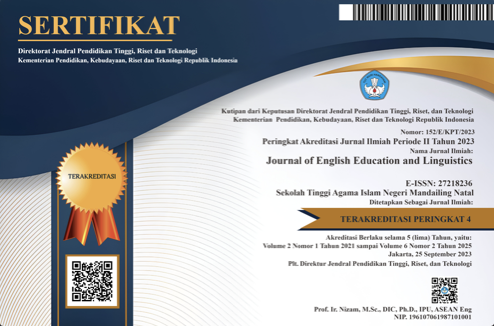CELEBRATING FLORES DE MAYO: AN IN-DEPTH LOOK AT THE CULTURE AND TRADITION IN BRGY. DANCALAN, DONSOL, SORSOGON.
DOI:
https://doi.org/10.56874/jeel.v4iJournal%20of.1315Keywords:
Flores de Mayo, Brgy. Dancalan, Donsol, Sorsogon, culture, traditionAbstract
In the Philippines, Flores de Mayo is a well-known religious and cultural celebration that typically takes place in the month of May. The culmination of the month-long celebration is the Santacruzan procession, also referred to as the "Queen of May" pageant. The goal of this research is to give readers a thorough understanding of Flores de Mayo in Brgy. Donsol, Sorsogon, and Dancalan.
In order to collect information from the local population and important informants, the study used qualitative research techniques like interviews and observations. Members of the community with knowledge and expertise with Flores de Mayo made up the study's participants.
The study's findings demonstrated the significance of Flores de Mayo in Brgy culture and tradition. Dancalan. Many religious and cultural customs are observed during the event, including the recitation of prayers, the giving of flowers, and the participation of young girls in the Santacruzan procession.
The survey also discovered that over time, Flores de Mayo celebrations have changed as new customs and practices have been added. For instance, the festival now includes a street dancing competition, which is a well-liked occasion in the neighbourhood.
This study sheds light on Flores de Mayo's cultural and religious significance in Brgy. Donsol, Sorsogon, and Dancalan. The festival, which has changed over time to incorporate new customs and practices, is a significant aspect of the culture and heritage of the neighborhood. The study emphasizes the value of protecting and fostering local communities' cultural heritage
References
Sorsogon. Unpublished master's thesis, Sorsogon State College.
Del Rosario, M. (2017). The Evolution of Flores de Mayo. Philippine Daily Inquirer. Retrieved
from https://newsinfo.inquirer.net/899672/the-evolution-of-flores-de-mayo
Espina, E. (2015). Santacruzan: A Unique Philippine Festival. Philippine Primer. Retrieved from
https://primer.com.ph/event/2015/06/11/santacruzan-a-unique-philippine-festival/
National Commission for Culture and the Arts. (2014). Flores de Mayo. Retrieved from
http://ncca.gov.ph/about-culture-and-arts/culture-profile/glimpses-peoples-culture/flores-de-mayo/
Philippine Daily Inquirer. (2019, May 29). Flores de Mayo in Sorsogon showcases street dancing.
Retrieved from https://newsinfo.inquirer.net/1120407/flores-de-mayo-in-sorsogon- showcases-street-dancing
Philippine Information Agency. (2018). Flores de Mayo in Donsol, Sorsogon. Retrieved from
https://pia.gov.ph/news/articles/1013157
Reyes, P. (2019). Why Flores de Mayo is a Fitting Celebration for the Month of May. Manila
Bulletin. Retrieved from https://mb.com.ph/2019/05/05/why-flores-de-mayo-is-a-fitting-celebration-for-the-month-of-may/
Santos, F. M. (2016). Flores de Mayo: A celebration of beauty, faith and culture. Philippine
Information Agency. Retrieved from https://pia.gov.ph/news/articles/1601467031999
Velasco, M. G. (2014). The history and evolution of Flores de Mayo. In J. C. Gonzales (Ed.),
Culture and tradition in the Philippines (pp. 145-156). Quezon City: University of the Philippines Press.
Downloads
Published
Issue
Section
License
All articles published in the Journal of English Education and Linguistics are licensed under a Creative Commons Attribution-ShareAlike 4.0 International (CC BY-SA) license. This means anyone is free to copy, transform, or redistribute articles for any lawful purpose in any medium, provided they give appropriate attribution to the original author(s) and Journal of English Education and Linguistics, link to the license, indicate if changes were made, and redistribute any derivative work under the same license.
Copyright on articles is retained by the respective author(s) without restrictions. A non-exclusive license is granted to the Journal of English Education and Linguistics to publish the article and identify itself as its original publisher, along with the commercial right to include the article in a hardcopy issue for sale to libraries and individuals.
Although the conditions of the Creative Commons Attribution-ShareAlike 4.0 International (CC BY-SA) license do not apply to authors (as the copyright holder of your article, you have no restrictions on your rights), by submitting to the Journal of English Education and Linguistics, authors recognize the rights of readers and must grant any third party the right to use their articles to the extent provided by the license.

This work is licensed under a Creative Commons Attribution-ShareAlike 4.0 International License.








